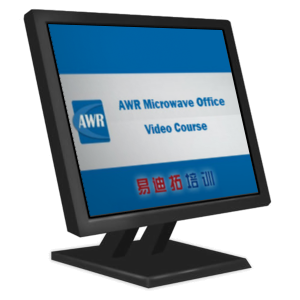
AWR Microwave Office Fundamentals
英文视频培训教程
英文原版讲解,共三讲十四小节视频课程
帮助你快速熟悉AWR Microwave Office的使用...
- 个人专业版
- U盾版
- 企业版
- 价格
- 99元
- 189元
- 269元
全长三个多小时视频课程,原版英文讲解。课程从零讲起,讲解AWR Microwave Office的用户界面、仿真设计流程和具体操作,同时有讲解并实际演示了非线性电路的HB仿真设计,以及Microwave Office中Layout的相关设置操作。课程共3部分14小节,可以帮助用户快速入门熟悉AWR Microwave Office的仿真设计使用,具体内容如下:
Lecture 1:A tour of Microwave Office
This tutorial of Microwave office is designed to get you up and running MWO quickly. It provides a quick tour of the Microwave Office design flow, from project creation to simulation to measurement graphs. There are five parts in this module. The full module covers:
Part 1:Microwave Office Environment and UI
In this part, you'll learn about libraries and start a new project. You'll then draw a schematic and place elements and ports.
Part 2: Microwave Office Environment and UI (cont.)
In this part, you'll make graphs, put measurements on the graphs, and add a subcircuit to the graph.
Part 3: Shortcut Features and Hotkeys
This part demonstrates some key shortcut features in the software that make designing in a project faster and easier, including running scripts, creating hot keys, and using the tuning bar to quickly change parameter values.
Part 4: Drawings
This part demonstrates how to create a layout from a schematic, draw polygons, and bring in artwork cells, then export your layout.
Part 5: AXIEM EM Simulation
This part overviews EM simulation using the AXIEM planar EM simulator and explains extraction, 3D and mesh viewing, and comparing simulation results with model results.
Lecture 2: Harmonic Balance Simulation
This module explains how to set up and work with the APLAC harmonic balance (HB) in Microwave Office circuit design for nonlinear circuits. The entire video is approximately 1 hour in length.The full module covers:
Part 1: HB Overview
This part explains why HB is needed, what it does and how to set it up using a power amplifier example. Topics covered include harmonics and sub-circuits.
Part 2: Measurements in HB
This part covers how to make measurements in HB. The second harmonic balance simulator within the software, the APLAC simulator, is introduced. You'll learn how to find harmonics and how to use the four common nonlinear measurements: PAE, PT, PHARM, and LSS nonlinear S-parameters.
Part 3: Two-tone simulation (IMD/IP3)
This part provides an example showing how to set up IP2 two tones in a power amplifier situation. The intermodulation distortion measurement is shown.
Part 4: Harmonic settings and Sweeping over power
This part covers two settings that are needed in order to run HB: fundamental frequency and number of harmonics. You'll learn where to set the fundamental frequency and what the options are, as well as how to set the number of harmonics. Sweeping over input power is also discussed.
Part 5: A mixer design example
This part shows you how the software's built-in IP3 measurement works and how to set up harmonic balance for a mixer design.
Lecture 3: Layout Basics
This module provides a tour of layout in Microwave Office and helps you understand how to set everything up correctly about layout in Microwave Office.
Part 1: Tips and tricks of Layout
This part looks at the two worlds of layout: schematic layout view and artwork cells. You'll learn about draw layers and model layers and how to load a library with a layout process file (LPF) to help in drawing layers. You'll learn about the different ways to get elements into the schematic layout, including PCells and drawing shapes.
Part 2: Drawing Basics
This part talks about drawing basics and provides useful drawing tips. You'll learn how to use the LPF file in your project to draw your layers.
Part 3: Import and Export
This part discusses model layers and how to import and map them to draw layers as artwork cells for use in the schematic layout.
Part 4: Layout Cell
This part addresses layout cells and shows you how to place an artwork cell in a schematic layout and make changes. You'll learn how to map your schematic layout for export. Addressing line types in raw LPF files is covered, especially for MMIC designers.
注:在线试看片段作了压缩处理,课程的实际效果比此处的在线演示片断更加清晰。您也可以下载该视频试看片段到本机播放【点击下载高清片段】。
 ADS是美国Agilent公司研发的微波射频电路、通信系统和MMIC/RFIC仿真设计软件,其功能强大、应用广泛,被国内高校、科研院所和大型IT公司广泛使用。掌握ADS,对于射频工程师来说无异于如虎添翼,可以有效提升自己的技术实力、提高工作效率。高级套装中包含易迪拓培训全10门ADS培训课程和教材,帮助学员全面深入学习掌握ADS的设计应用。【详细...】
ADS是美国Agilent公司研发的微波射频电路、通信系统和MMIC/RFIC仿真设计软件,其功能强大、应用广泛,被国内高校、科研院所和大型IT公司广泛使用。掌握ADS,对于射频工程师来说无异于如虎添翼,可以有效提升自己的技术实力、提高工作效率。高级套装中包含易迪拓培训全10门ADS培训课程和教材,帮助学员全面深入学习掌握ADS的设计应用。【详细...】 最新版ADS的入门和进阶培训课程,适合ADS2011 ~ ADS2014 版本ADS的学习。李明洋主讲,高清视频,直观易学。课程从基础讲起,通过设计实例,边操作边讲解,全面讲授了ADS在射频电路的仿真设计、微波平面电路的电磁仿真分析和RFIC设计的工程应用。通过该门课程的学习,可以帮助你快速上手掌握ADS的使用,并实现把ADS应用实际工作中去【详细...】
最新版ADS的入门和进阶培训课程,适合ADS2011 ~ ADS2014 版本ADS的学习。李明洋主讲,高清视频,直观易学。课程从基础讲起,通过设计实例,边操作边讲解,全面讲授了ADS在射频电路的仿真设计、微波平面电路的电磁仿真分析和RFIC设计的工程应用。通过该门课程的学习,可以帮助你快速上手掌握ADS的使用,并实现把ADS应用实际工作中去【详细...】 本课程基于新版的ADS软件,由李明洋老师讲授,讲解了ADS在微波射频模拟电路设计中的具体应用。课程为全程高清视频,边操作边讲解,直观易学,能够帮助你在最短的时间内学习掌握ADS的使用操作;课程同时结合工程设计实例来讲解,能够让你在学完之后,迅速地把ADS应用到微波射频电路的研发工作中去,真正学有所用,提升你的技术水平和工作效率【详细...】
本课程基于新版的ADS软件,由李明洋老师讲授,讲解了ADS在微波射频模拟电路设计中的具体应用。课程为全程高清视频,边操作边讲解,直观易学,能够帮助你在最短的时间内学习掌握ADS的使用操作;课程同时结合工程设计实例来讲解,能够让你在学完之后,迅速地把ADS应用到微波射频电路的研发工作中去,真正学有所用,提升你的技术水平和工作效率【详细...】 该门课程旨在帮助学员快速、全面、透彻地理解高低阻抗线微带滤波器的设计原理和设计步骤,帮助学员学会并掌握使用ADS软件仿真分析和优化设计微带线滤波器的实际操作,包括微带线滤波器的原理图电路的分析和优化、Layout版图结构的分析和设计优化,以及如何使用ADS DesignGuide来快速设计高低阻抗线微带滤波器【详细...】
该门课程旨在帮助学员快速、全面、透彻地理解高低阻抗线微带滤波器的设计原理和设计步骤,帮助学员学会并掌握使用ADS软件仿真分析和优化设计微带线滤波器的实际操作,包括微带线滤波器的原理图电路的分析和优化、Layout版图结构的分析和设计优化,以及如何使用ADS DesignGuide来快速设计高低阻抗线微带滤波器【详细...】
